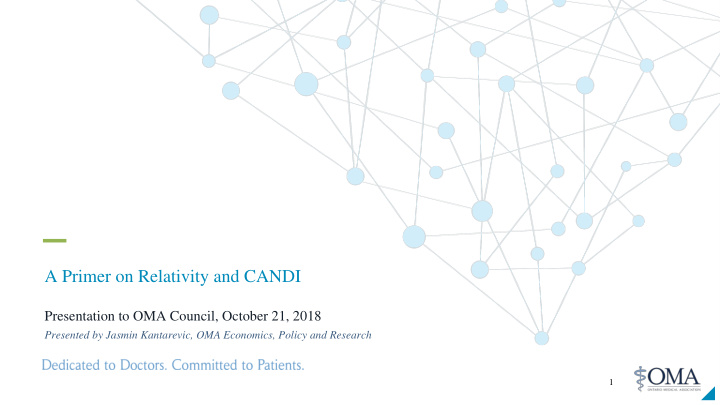



A Primer on Relativity and CANDI Presentation to OMA Council, October 21, 2018 Presented by Jasmin Kantarevic, OMA Economics, Policy and Research 1
Overview 1. Overview of relativity and OMA past initiatives 2. Primer on CANDI • More details available at: https://www.oma.org/sections/billings-and-agreement/research-analytics/relativity/ 2
What is Relativity? • Equal pay for equal work • Two main types: 1. Fee-based relativity : e.g. equal pay for services that have equal time requirement, intensity, complexity, risk, overhead cost, etc. 2. Income-based relativity : e.g. equal pay for physicians with equal hours of work, overhead, length of training, etc. 3
OMA Experience with Relativity Fee Based • 1992 – 1997 : OMA Resource-Based Relative Value Scales (RBRVS) • 1997 - 2002 : RBRVS Commission Income Based • 2003 – 2009: Relative Value Implementation Committee (RVIC) model • 2009 – 2018: Comparison of Adjusted Net Daily Income (CANDI) model 4
History of CANDI • 2008-2009: RVIC Methodology Review Committee - CANDI approved by Council • 2009-2012: CANDI Relativity Implementation Committee - October 2011: PricewaterhouseCoopers Study - Revisions to hours of work and overhead • 2017-2018: Relativity Review Committee - recommendations based on technical reports and new data on after-hours • 2018 - : Relativity Advisory Committee 5
CANDI Allocation in 2008 PSA Fee-Based Income-Based Intra-Sectional Relativity Inter-Sectional Relativity • Each Specialty proposes changes • Each Specialty receives to their fee codes CANDI score • Proposals based on fee relativity • Based on CANDI score, • Proposals assessed by bilateral each Specialty receives members of MSPC funding allocation 6
CANDI Formula Adjusted Net Gross Training Overhead Daily Income Income Premium 7
Gross Income: Income Sources Included • Professional fee-for-service billings ($7.1B) • Clinical Primary Care payments (e.g. capitation, access bonus, CCM fee) ($1.8B) Data Source: • Clinical Alternative Payment Plans payments ($1.125B) MOHLTC Administrative • Data Files Hospital On-Call Coverage (HOCC) payments ($223M) ($10.4B) • Workplace Safety and Insurance Board (WSIB) payments ($25M) • Other Specialty-Specific payments (e.g. psychiatric sessional payments) ($137M) Excluded • Technical billings • Non-clinical payments • Private, non-insured income 8
Gross Income: Time Period Weekday (Monday to Friday) daytime (7:00-17:00) standardized daily income Exclude Weekends and Holidays Exclude After-Hours Payments Based on Schedule 00:00 – of Benefits fee codes/RRC Survey 6:69 7:00 – 16:59 Based on Schedule 17:00 – of Benefits fee 23:59 codes/RRC Survey 9
Gross Income: Hours of Work Weekday (Monday to Friday) daytime (7:00-17:00) standardized daily income 7:00 Hours of Work Data Source Start time: e.g. 8:30 • PricewaterhouseCoopers 2010 Study • Questions about start time, finish time, percent of work that is strictly clinical • OHIP specialties with low response rates assigned average hours of work for their respective Assembly Finish time: e.g. 16:00 16:59 10
Overhead Data Sources • 2009 OMA Human Resources Committee Survey • 2011 OMA Human Resources Committee Survey Weighted average of three surveys • PricewaterhouseCoopers 2010 Study Validation • 400 site visits for PwC Study • 1997 Canada Revenue Agency (overhead within ± 20% of CRA) 11
Training Premium: Concept PARO earnings for Family Physician PARO earnings for Specialist B Practice earnings for Family Physician Specialist Practice earnings for Specialist Family Physician A A = lost opportunity cost B = opportunity cost + skill premium Retirement PGY1 PGY2 PGY5 12
Training Premium: Estimates Overall training premium 6.4% per year Opportunity Cost Premium Years of Training CANDI Specialties Average Training Premium • Actuarial study (Prof. Hyatt, Rotman) (relative to Family Medicine) • About 2.4 percent for additional year 3 Emergency Medicine 6% 4.2 Pediatrics 13% Internal Medicine Skill Acquisition Premium 5.1-5.3 All Other 19-20% • 6.2 – 6.4 Cardiac Surgery 26-28% 4 percent per additional year Neurosurgery Cardiology 13
Adjusted Net Daily Income and CANDI Scores 14
Additional Resources: https://www.oma.org/sections/billings-and-agreement/research-analytics/relativity Questions? relativity@oma.org 15
Recommend
More recommend